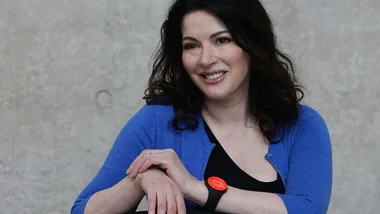Some types of cuisine are notorious for high-fat offerings, but that doesn’t mean you have to forgo a dinner invitation or blow your eating plan entirely.
“It’s not a question of avoiding certain cuisines but rather limiting your portions if they don’t support your focus on health,” says body-confidence expert and exercise physiologist Dr Katherine Iscoe.
One way to do this is by monitoring the amount and type of foods you eat, especially if you’re being presented with western-world servings that are significantly larger than their country-of-origin counterparts.
“In some cases, modern dishes can be as much as 10 times the original size,” says Dr Iscoe, adding that you can enjoy your favourite foods as long as they are consumed in moderation.
Plan ahead of time
Dining out needn’t be a challenge, it just requires some planning and careful choices.
For example, if you’re able to decide what you’re going to order beforehand you’ll be less likely to run into difficulty – or at least be prepared for the situation.
One of the best ways to plan ahead is checking a restaurant’s menu online. Then you can determine which dishes seem like healthy meal choices.
“Reading the menu ahead of time can help you to make a more informed decision that stays in line with your eating plan,” Dr Iscoe says.
Having an idea of what you would like to eat also takes the pressure out of ordering on the spot.
“Once you’re at the restaurant, the flow of conversation can make it difficult to come to a decision, so you might feel like you’re being rushed when it’s time to order,” she says.
Other ways to ensure you don’t overdo things include eating light the day before, not drinking alcohol on the night and sharing dishes with others.
Decode the menu
Keeping up-to-date with menu jargon and cooking terminology can make ordering easier, particularly if you’re counting kilojoules or have special dietary requirements.
“It’s important to choose your food carefully and watch out for high-fat words that are hidden on menus,” Dr Iscoe advises.
Culinary terms that indicate a meal is rich or heavy include “au gratin”, “confit”, “buttered”, “creamed”, “sautéed”, “deep-fried” and “pan-fried”.
“It’s not that fat is always bad for you, but if you’re looking for lighter meals stick to items that are grilled, steamed or oven-baked,” she says.
Other low-fat menu words to watch for are “poached”, “roasted”, “steamed”, “stir-fried” and “broiled” – which usually refers to meat cooked with dry heat.
“At the end of the day, food is a beautiful pleasure and it’s something that should be enjoyed, but you do have to aim for moderation,” Dr Iscoe says.
Have your cake and eat it, too!
• If you’re being really strict, you could wait until you arrive home to satisfy your sweet tooth with a piece of fruit, but Dr Iscoe says you shouldn’t always have to pass on the banoffee pie if that’s what you really fancy – just be smart about how much of it you eat.
• One way to have your cake and eat it too is to ask for a sample of a few different desserts and then share them among the table. “Many restaurants offer a dessert tasting menu, which is a very clever way of slowing down the meal because you get to talk about each of the different tastes and textures and share the experience with others,” she says.
Be the first to order
Even with the strongest willpower, hearing a friend order duck confit or truffle fries could persuade you to do the same – so order first. Research shows you’re less likely to order an unhealthy meal if you follow this simple instruction.
If you can’t get in first, sidestep temptation by closing the menu and repeating your selection to yourself until it’s your turn. Then again, you could just split that rich must-have dish with your dining companion.
“Sharing is an excellent way to enjoy a bit of everything. Just make sure you don’t let your friends coerce you into ordering something you don’t want to eat,” Dr Iscoe says.
If there’s a particular dish you’re unsure about, simply ask the waiter.
“Enquire about how it’s prepared, what ingredients are used, how large the portion is, if there’s a low-fat option, and whether any sides come with it,” she says.
Don’t be afraid to make special requests, such as asking for your meal to be served without butter or additional salt.
Skip a course
Some restaurants serve large portions loaded with carbohydrates, which means a multi-course meal can add up to more than a day’s worth of kilojoules.
“Instead of ordering an entree, main and dessert, consider ordering two entrees,” Dr Iscoe suggests.
“If you’re still hungry, you can always order more, but you won’t find yourself eating more than you initially wanted.”
You can also ask for courses to be served at a relaxed pace so you’re not rushing the meal, as you’re more likely to overeat when you speed through.
“And remember, you’re not just there for the food but also the dining experience with others,” she says.
Watch your drinks
Whether you’re trying to lose weight or not, Dr Iscoe says you have to think about alcohol from a health point of view.
“Alcohol is very kilojoule-dense, so it’s a sure-fire way to add unwanted inches to your waistline,” she says. While the occasional tipple with dinner is fine, alternate each drink with a glass of water to slow down your rate of consumption.


